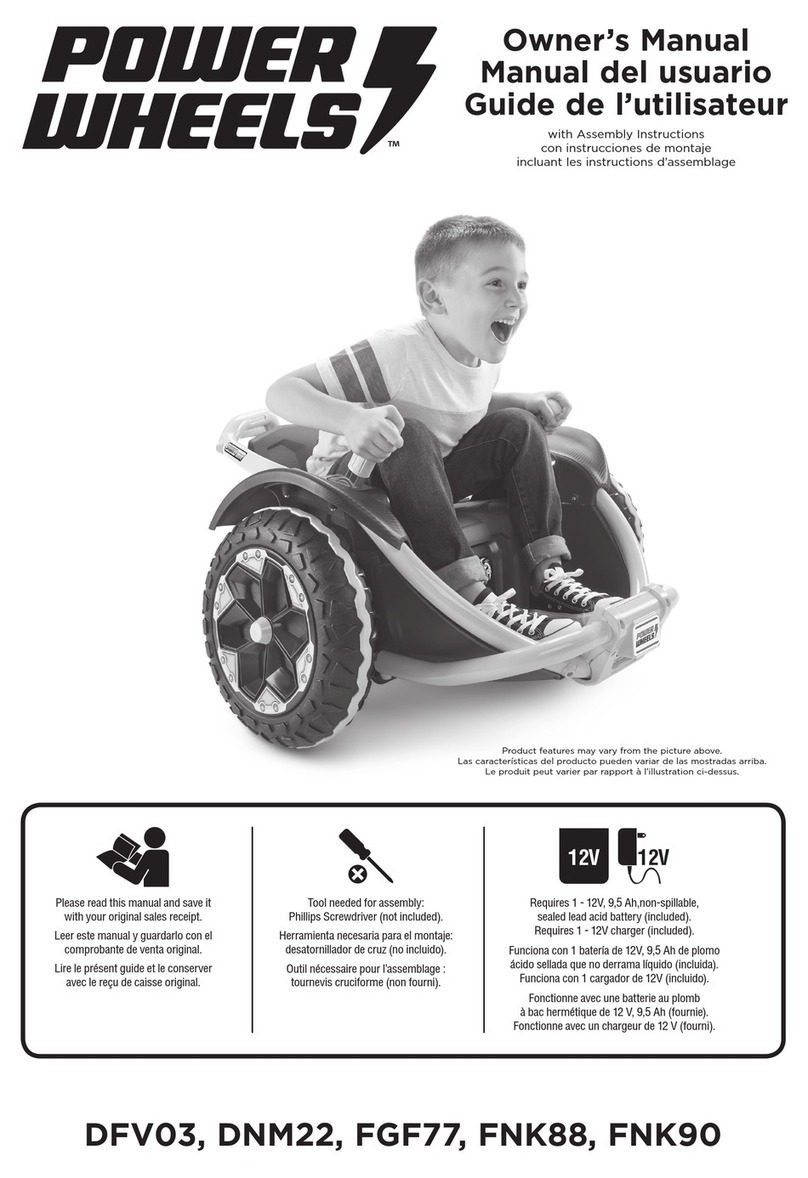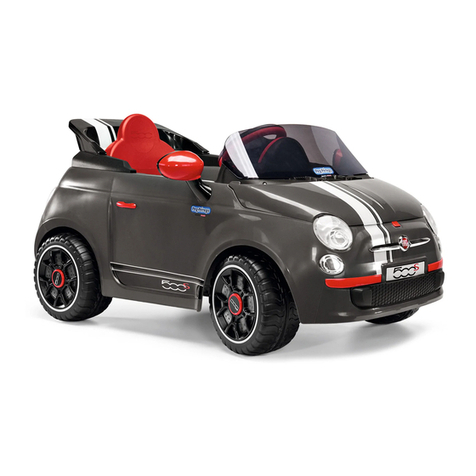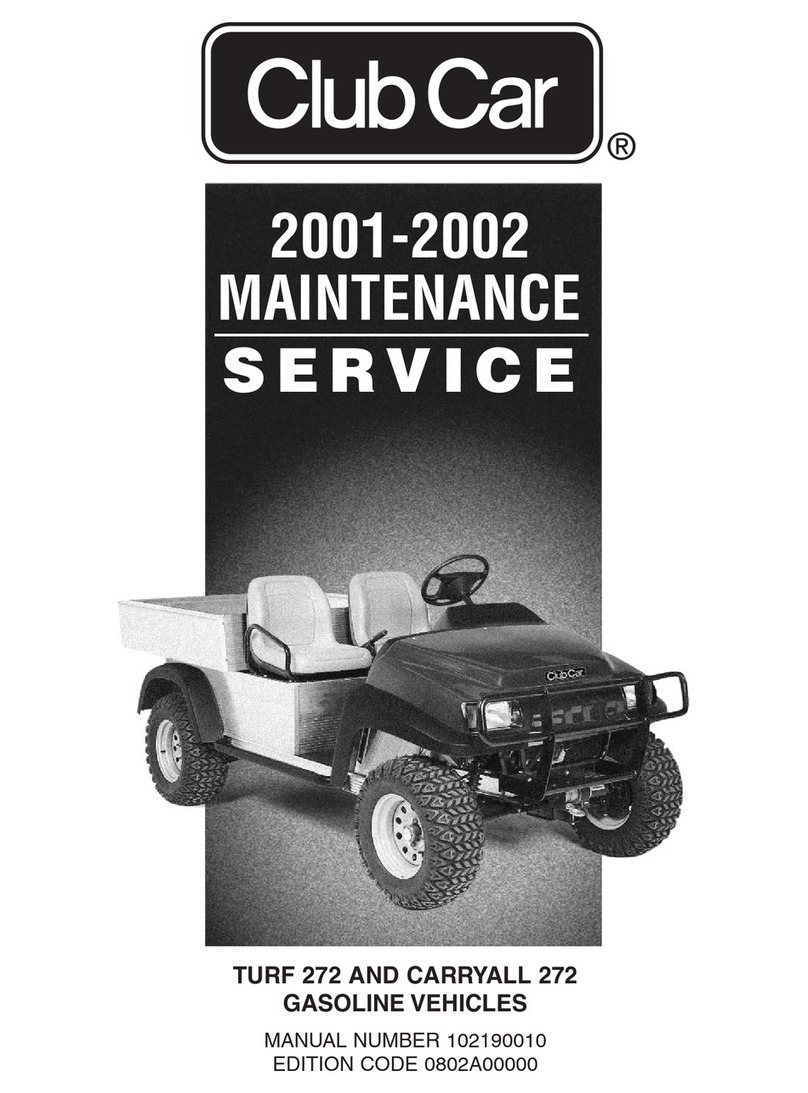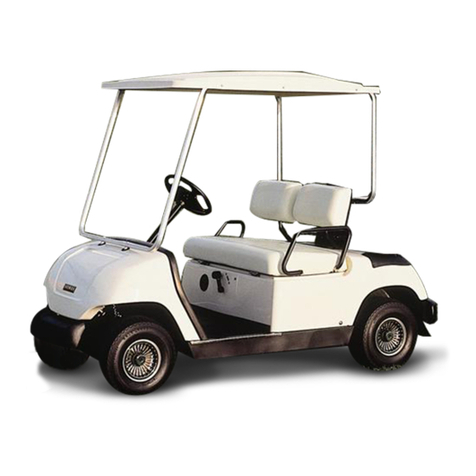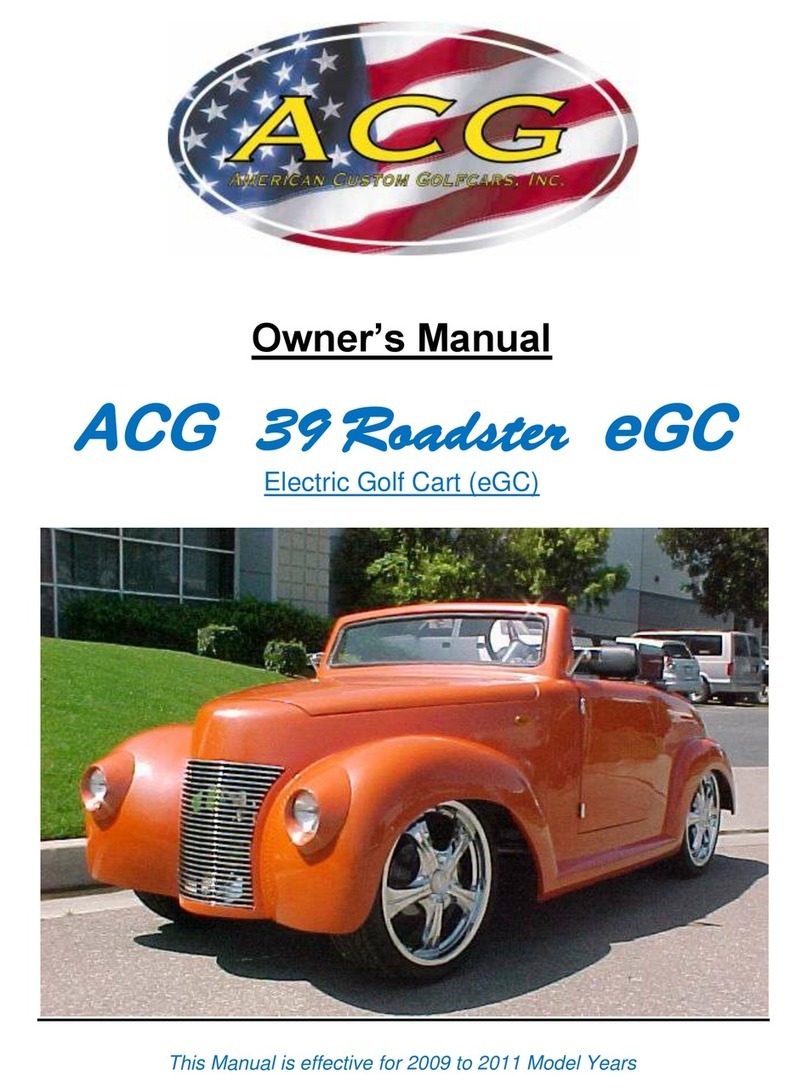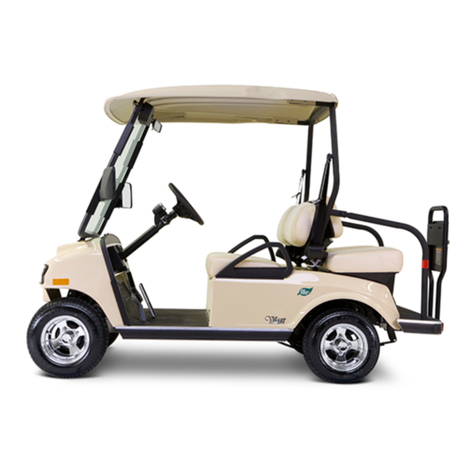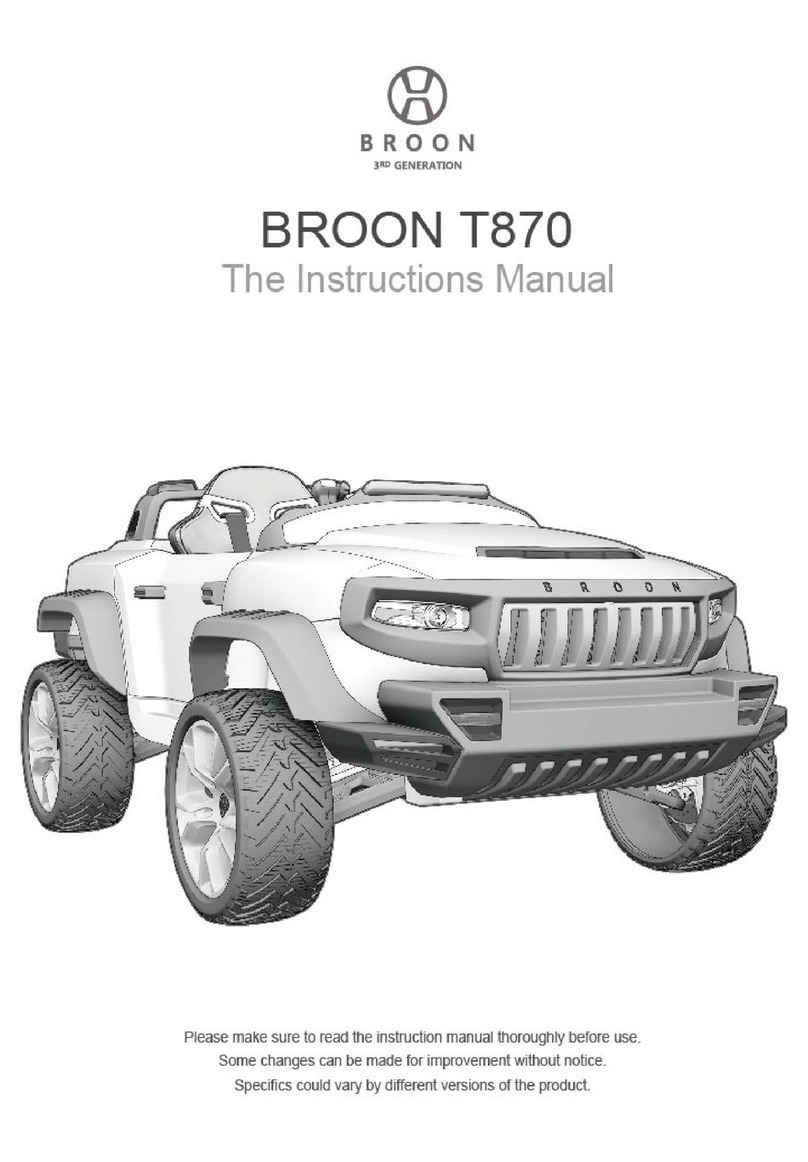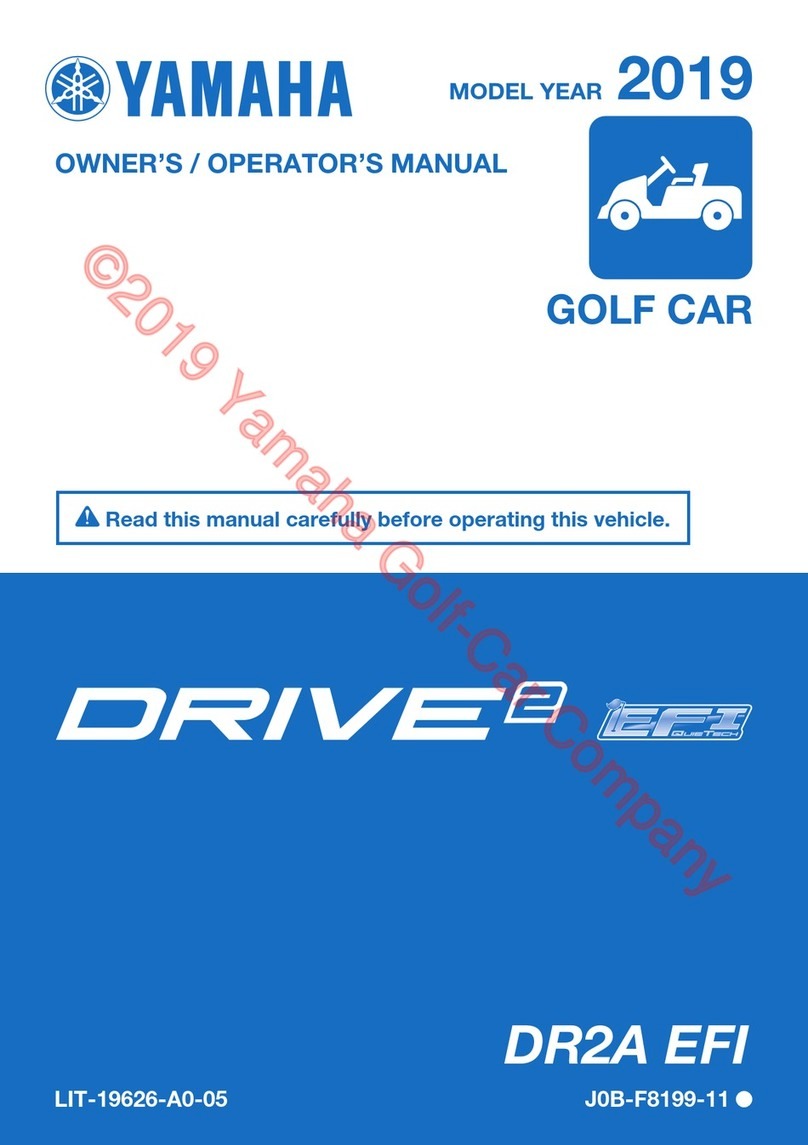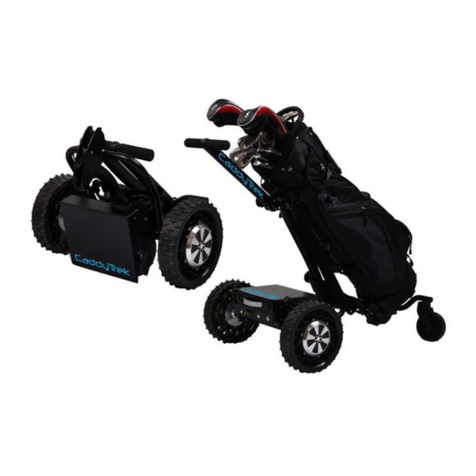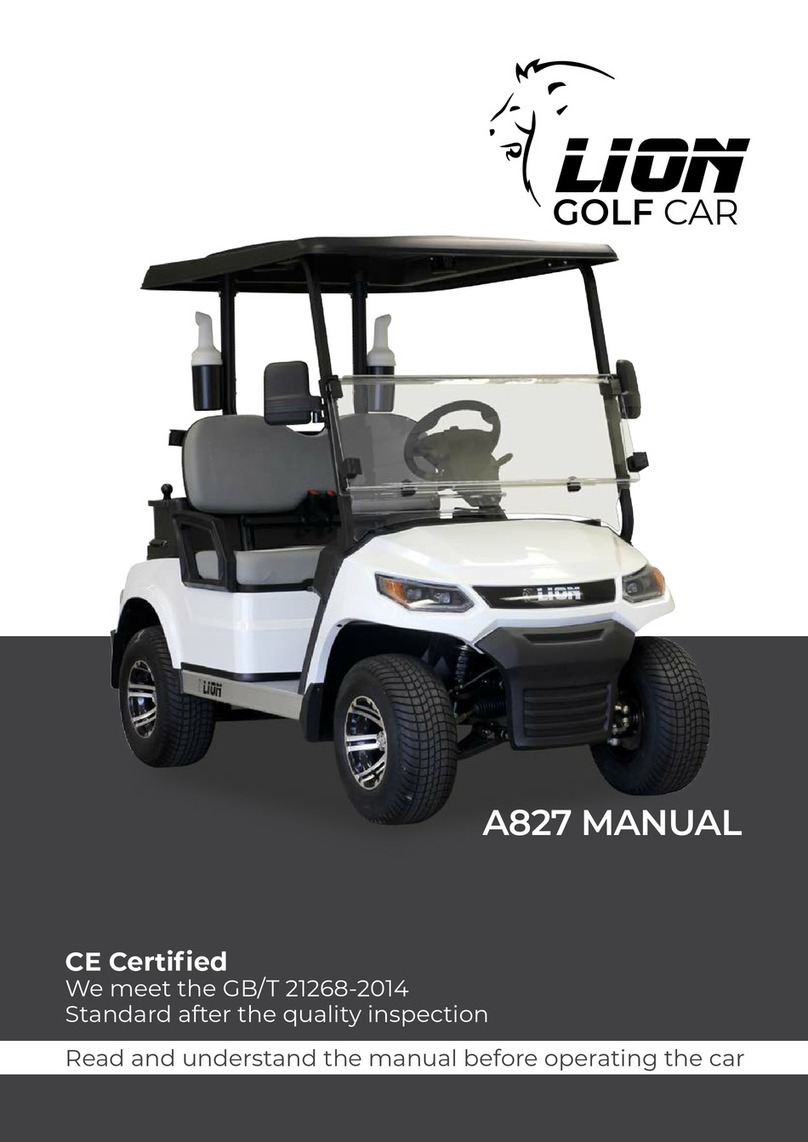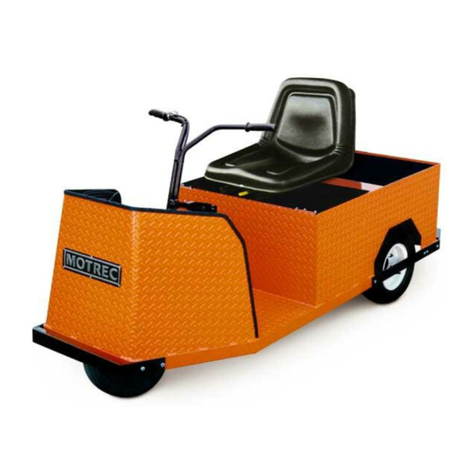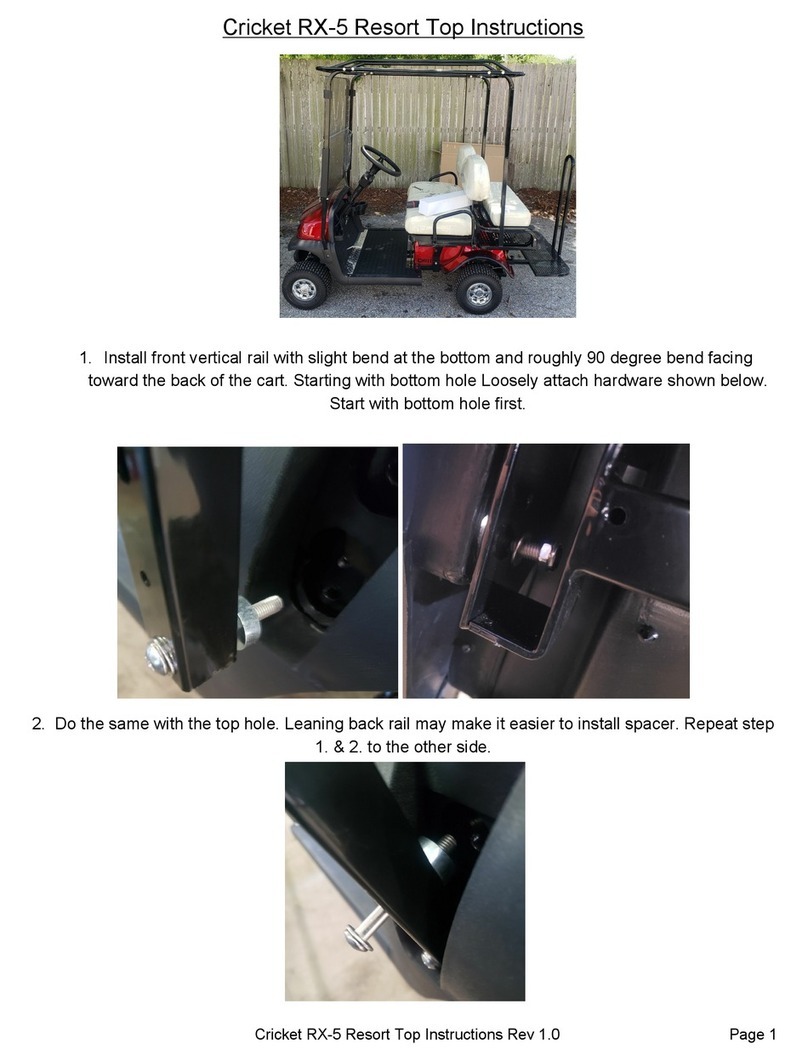Power Wheels Barbie User manual

Owner's Manual
with Assembly Instructions
For Model B2008
Product features may vary from the picture above.
Please read this manual and save it with your original sales receipt.
Tools needed for assembly: Phillips Screwdriver, Slotted Screwdriver, Hammer
and Pliers (not included); Cap Nut Assembly Tool (included).
Use only with a Power Wheels®6 Volt Rechargeable Battery with A-Style Connector and Built-in
Thermal Fuse and a Power Wheels®Super 6™Volt Charger (both included).

2
Table of Contents
Important Information
•Your new vehicle requires adult assembly. Please set
aside at least 45 minutes for assembly.
•You must charge your battery for 18 - 30 hours
before you use your vehicle for the first time.We
recommend that you start charging your battery before
beginning assembly. Please see Battery Charging
beginning on page 7 for detailed instructions.
•Read this manual carefully for important safety
information and operating instructions before using
your vehicle. Keep this manual for future reference
as it contains important information.
•This vehicle is designed for use on grass, asphalt or
other hard surfaces; on generally level terrain; by
children 3 - 6 years of age.
•Make sure children know and follow these rules for safe
driving and riding:
-always sit in the seat.
-always wear shoes.
-only one (1) rider at a time.
•Use this vehicle ONLY outdoors. Most interior floor-
ing can be damaged by riding this vehicle indoors.
Fisher-Price®will not be responsible for damage to
the floor if the vehicle is used indoors.
•To prevent damaging the motors and gears, teach your
child to stop the vehicle before switching between
forward and reverse. Do not tow anything behind the
vehicle or overload it. Do not exceed the maximum
weight capacity of 65 lb (29.5 kg).
A
•If you have any questions about your Power Wheels®
vehicle, please call our toll-free service lines at
1-800-348-0751 from 8 AM to 6 PM (EST) Monday
through Friday.Trained customer service representatives
are available to take your call in English or French.
Habla Español? Si usted tiene alguna pregunta ó
necesita asistencia llame gratis 1-800-348-0755 para los
Estados Unidos.Tenemos representantes que hablan
español para atender su llamada.
•For your convenience, Power Wheels®maintains an
independently owned and operated Authorized
Service Center Network with more than 400 authorized
service centers nationwide.The authorized service
centers will repair or replace parts under warranty at no
extra charge, and can perform non-warranty repairs for
a minimal charge. Please see the Authorized Service
Center list beginning on page 24 to find the authorized
service center nearest you, or call 1-800-348-0751.
•Please complete and return the enclosed Registration
Card today, or call 1-800-348-0751 to register your
vehicle by phone, or register on-line at
www.powerwheels.com.
AImportant Information . . . . . . . . . . . . . . . . . . . . . . . . . . . . . . . . . . . . . . . . . . . . . . . . . . . . . . . . . . . . . . . . . . . . .2
BWarnings and Cautions . . . . . . . . . . . . . . . . . . . . . . . . . . . . . . . . . . . . . . . . . . . . . . . . . . . . . . . . . . . . . . . . . . .3
CParts . . . . . . . . . . . . . . . . . . . . . . . . . . . . . . . . . . . . . . . . . . . . . . . . . . . . . . . . . . . . . . . . . . . . . . . . . . . . . . . . .4
DParts Diagram . . . . . . . . . . . . . . . . . . . . . . . . . . . . . . . . . . . . . . . . . . . . . . . . . . . . . . . . . . . . . . . . . . . . . . . . . . .6
EBattery Charging . . . . . . . . . . . . . . . . . . . . . . . . . . . . . . . . . . . . . . . . . . . . . . . . . . . . . . . . . . . . . . . . . . . . . . . . .7
FAssembly . . . . . . . . . . . . . . . . . . . . . . . . . . . . . . . . . . . . . . . . . . . . . . . . . . . . . . . . . . . . . . . . . . . . . . . . . . . . . .9
GLabel Decoration . . . . . . . . . . . . . . . . . . . . . . . . . . . . . . . . . . . . . . . . . . . . . . . . . . . . . . . . . . . . . . . . . . . . . . . .15
HBattery Installation . . . . . . . . . . . . . . . . . . . . . . . . . . . . . . . . . . . . . . . . . . . . . . . . . . . . . . . . . . . . . . . . . . . . . .17
IBattery Care and Disposal . . . . . . . . . . . . . . . . . . . . . . . . . . . . . . . . . . . . . . . . . . . . . . . . . . . . . . . . . . . . . . . .18
JCaring ForYour Vehicle . . . . . . . . . . . . . . . . . . . . . . . . . . . . . . . . . . . . . . . . . . . . . . . . . . . . . . . . . . . . . . . . . . .18
KRules For Safe Driving . . . . . . . . . . . . . . . . . . . . . . . . . . . . . . . . . . . . . . . . . . . . . . . . . . . . . . . . . . . . . . . . . . .19
LHow to OperateYour Vehicle . . . . . . . . . . . . . . . . . . . . . . . . . . . . . . . . . . . . . . . . . . . . . . . . . . . . . . . . . . . . . . .20
MFCC Statement (United States Only) . . . . . . . . . . . . . . . . . . . . . . . . . . . . . . . . . . . . . . . . . . . . . . . . . . . . . . . . .20
NProblems and Solutions Guide . . . . . . . . . . . . . . . . . . . . . . . . . . . . . . . . . . . . . . . . . . . . . . . . . . . . . . . . . . . . .21
OStatement of Limited Warranty . . . . . . . . . . . . . . . . . . . . . . . . . . . . . . . . . . . . . . . . . . . . . . . . . . . . . . . . . . . . .24
PAuthorized Service Centers . . . . . . . . . . . . . . . . . . . . . . . . . . . . . . . . . . . . . . . . . . . . . . . . . . . . . . . . . . . . . . . .27

3
Warnings and Cautions
B
CAUTION
•In the unassembled state, this package contains small parts. Adult assembly is required.
•Use the charger in dry locations only.
WARNING
•Prevent Injuries and Deaths
• Direct Adult Supervision Required
• Keep Children Within Safe Riding Areas.
These areas must be:
- away from swimming pools and other bodies of water to prevent drownings
- generally level to prevent tipovers
- away from steps, driveways, cars, roads and alleys.
RIDING HAZARD
WARNING
•Battery can fall out and injure a child if vehicle tips over. Always use battery clamp.
•PREVENT FIRE
- Never modify the electrical system. Alterations could cause a fire resulting in serious
injury and could also ruin the electrical system.
- Use of the wrong type battery or charger could cause a fire or explosion resulting in
serious injury.
- Use of Power Wheels®components in products other than Power Wheels®vehicles
could cause overheating, fire or explosion.
•The battery must be handled by adults only.The battery is heavy and contains sulfuric
acid (electrolyte). Dropping the battery could result in serious injury.
•Never allow children to charge the battery. Battery charging must be done by adults only.
A child could be injured by the electricity involved in charging the battery.
•Never lift or carry the battery by the wires or connector.This can damage the battery and
possibly cause a fire resulting in serious injury. Lift and carry the battery by the case only.
•Read the safety instructions on the battery.
•Examine the battery, charger and their connectors for excessive wear or damage each time
you charge the battery. If damage or excessive wear is detected, do not use the charger or
the battery until you have replaced the worn or damaged part.
•HOT motors. Handle carefully.
ELECTRICAL HAZARD

4
Parts
C
Wheel - 4
Handlebar Assembly
Front Back
•If you experience a problem with this product, or are missing a part, please call us at 1-800-348-0751, rather than
return this product to the store.
•Please identify all parts before assembly and save all packaging material until assembly is complete to ensure that no
parts are discarded.
•Some parts were placed under the seat for shipment. Press the tab under the back of the seat and lift to access the
battery compartment.
•Metal parts have been coated with a lubricant to protect them during shipment.Wipe all metal parts with a paper towel
to remove any excess lubricant.
Rear Wheel Driver - 2
Cowling
Hubcap - 4
Steering Column
Vehicle Body (with Seat)

5
All Shown Actual Size
Not Shown: Label Sheet
.437 Cap Nut – 6
7/16" Washer - 4
6 Volt Battery
Hex Bushing - 4
Round Bushing - 2
Cap Nut
Assembly Tool
#6 x 1/2" Screw - 2
#10 Lock Nut - 2
#6 x 1" Screw - 6
#10 x 15/8" Screw - 2
Microphone
®
6 Volt Charger
WARNING
PREVENTFIRE
•DonotbypassaPowerWheel
•UseonlyaRedPowerWheels
•Nevermodifytheelectrical
OROPERATE
Note: For your convenience, extra washers, screws and cap nuts may have been included.
Parts
Handlebar
Rear Axle
Steering Bushing
Foam Spacer
Note:Do not discard the
foam spacer packaged
with the battery. Save it
for use in the vehicle's
battery compartment.
Handlebar Neck
Hand Grip - 2

6
Parts Diagram
D
1. Vehicle Body
2. Cowling
3. Seat
4. Wheel - 4
5. Hubcap - 4
6. Cap Nut - 6
7. Steering Column
8. Steering Bushing
9. Handlebar - Front
10. Handlebar - Back
11. Microphone
12. 6 Volt Battery
13. Hand Grip - 2
14. Handlebar
15. 7/16" Washer - 4
16. Handlebar Neck
17. Hex Bushing - 4
18. Round Bushing - 2
19. Rear Wheel Driver - 2
20. #10 x 15/8" Screw - 2
21. Rear Axle
22. #10 Lock Nut - 2
23. #6 x 1/2" Screw - 2
24. #6 x 1" Screw - 6
25. Foam Spacer
26. 6 Volt Charger
Not Shown
Label Sheet
Cap Nut Assembly Tool
TM
1
26
3
11
24
24
14
13 9
8
4
19
5
5
17
17
6
7
15
2
20
20
16
12
6
21 15
18
25
®
23
22 22
24
6
6
4
Note: Some parts are assembled on both sides of the vehicle.
This illustration shows assembly on right side only. 10

7
Battery Charging
E
7
AboutThermal Fuses
Your Power Wheels®battery is equipped with a built-in
thermal fuse.The thermal fuse is a self-resetting safety
device which automatically “trips” and shuts down operation
of the vehicle if the vehicle is overloaded or the driving
conditions too severe. Once the fuse has “tripped”, it will
automatically reset itself after approximately 25 seconds
and allow the vehicle to resume normal operation.To avoid
repeated automatic shutdowns, do not overload the vehicle
by exceeding the 65 lb (29.5 kg) maximum weight capacity
or by towing anything behind the vehicle. Avoid severe
driving conditions, such as driving up very steep hills or
running into fixed objects, which can cause the wheels to
stop spinning while power is still being supplied to the
motors. Make sure your child stops the vehicle before
switching between forward and reverse.
If under normal use conditions the thermal fuse continually
trips, contact your local Power Wheels®Authorized Service
Center. Please refer to the Authorized Service Center
listing beginning on page 24 for the location of the
Authorized Service Center nearest to you.
CAUTION
Use the charger in dry locations only.
WARNING
•Battery can fall out and injure a
child if vehicle tips over. Always use
battery clamp.
•PREVENT FIRE
- Never modify the electrical system.
Alterations could cause a fire resulting
in serious injury and could also ruin
the electrical system.
- Use of the wrong type battery or
charger could cause a fire or
explosion resulting in serious injury.
- Use of Power Wheels®components
in products other than Power Wheels®
vehicles could cause overheating, fire
or explosion.
•The battery must be handled by adults
only.The battery is heavy and contains
sulfuric acid (electrolyte). Dropping the
battery could result in serious injury.
•Never allow children to charge the
battery. Battery charging must be done
by adults only. A child could be injured
by the electricity involved in charging
the battery.
•Never lift or carry the battery by the
wires or connector.This can damage
the battery and possibly cause a fire
resulting in serious injury. Lift and carry
the battery by the case only.
•Read the safety instructions on
the battery.
•Examine the battery, charger and
their connectors for excessive wear
or damage each time you charge the
battery. If damage or excessive wear is
detected, do not use the charger or the
battery until you have replaced the
worn or damaged part.
ELECTRICAL HAZARD
Important Notes
•Your new battery must be charged for at least
18 hours before you use it in your vehicle for
the first time.
•We recommend that you start charging your battery
before beginning assembly of your new vehicle.
•The battery must be upright while charging.
•The charger is not a toy.
•Do not short circuit the battery.
•You do not need to remove the battery from your vehicle
to recharge it.
•Before charging the battery, examine the battery case for
cracks and other damage which may cause sulfuric acid
(electrolyte) to leak during the charging process. If
damage is detected, do not charge the battery or use it
in your vehicle. Battery acid is very corrosive and can
cause severe damage to surfaces it contacts.
•Do not charge the battery on a surface (such as kitchen
counter tops) which could be damaged by the acid
contained inside the battery.Take precautions to protect
the surface on which you charge your battery.
•Use only a Power Wheels®Super 6™ Volt charger with
an A-style connector (120 VAC, 60 Hz, 15W with an
output of 6 VDC, 7.2W) to charge your 6 volt battery.
•If your battery is old and will not accept a charge, do not
leave it in the vehicle. Always remove a dead battery
from the vehicle.

®
WARNING
PREVENTFIRE
•DonotbypassaPowerWheel
•UseonlyaRedPowerWheels
•Nevermodifytheelectrical
PREVENTFIRE
•Donot bypassaPowerWheel
•UseonlyaRedPowerWheels
•Nevermodifytheelectrical
Avertissement
A-Style Battery
Connector
Battery Charging
•Plug the charger and battery connectors together.
Push firmly to make sure the two connectors are
completely joined.
•Plug the charger into a standard 120 volt wall outlet.
Note: If power flow to the wall outlet is controlled by a
switch, make sure the switch is “ON”.
•Before first time use, charge the battery for at
least 18 hours. Never charge the battery longer than
30 hours.
•Recharge the battery for at least 14 hours after each
use of your vehicle. Do not charge the battery longer
than 30 hours.
•Once the battery is charged, disconnect the charger
connector from the battery connector. Unplug the charger
from the wall outlet.The battery is now charged and is
ready to be installed in your vehicle. Please see
"Battery Installation" on page 17 for detailed battery
installation instructions.
Incorrect Correct
WARNING
PREVENTFIRE
•DonotbypassaPower Wheel
•UseonlyaRedPowerWheels
•Nevermodifytheelectrical
PREVENTFIRE
•Donot bypassaPowerWheel
•Useonly aRedPow erWheels
•Nevermodify theelectrical
Avertissement
A-Style Charger
Connector
GAP NO GAP
12
8

9
•Position the vehicle body upright.
•Fit and hold a rear wheel driver against the motor pins
on one end of the motor assembly.
•While holding the rear wheel driver in place, slide the
rear axle into the hole in the opposite side of the motor
assembly. Make sure the rear wheel driver on the rear
axle assembly fits onto the pins on the motor assembly.
•Take the rear wheel driver off the open end of the
rear axle.You will need to add a washer to the rear
axle and then re-asemble the rear wheel driver in the
next assembly step.
Rear Axle Assembly
Rear Axle
Motor Assembly Pins
Rear Wheel Driver
Vehicle Body
Assembly
•Fit a cap nut onto one end of the rear axle.
•Tap the other end of the rear axle with a hammer to
secure the cap nut on the end of the rear axle.
Note: You may want to position the cap nut on a scrap
block of wood to protect the assembly surface.
•Slide a hex bushing, ring side first, onto the rear axle.
•Slide a hubcap, ring side first, onto the rear axle.
•Slide a wheel onto the rear axle. Make sure the ribs on
the wheel face up.
•Slide a rear wheel driver, ring side first, onto the rear
axle. Fit the grooves on the rear wheel driver onto the
ribs on the wheel.
•Slide a washer onto the rear axle.
•Set the rear axle assembly aside.
Rear Axle
Cap Nut
Washer
Wheel Ribs Up
Hex
Bushing
Rear Wheel Driver
Hubcap
F
Children can be harmed by small parts,
sharp edges and sharp points in the
vehicle’s unassembled state, or by electrical
items. Care should be taken in unpacking
and assembly of the vehicle. Children
should not handle parts, including the
battery, or help in assembly of the vehicle.
WARNING
2
1
3
.437"
.437 Cap Nut
Ring
Side
Hex Bushing

10
•Slide a washer onto one of the front axles.
•Slide a round bushing, ring side first, onto the same
front axle.
•Slide a wheel onto the front axle.
•Slide a hubcap onto the front axle.
•Slide a hex bushing, barrel side first, onto the front axle.
•Fit a cap nut on the end of the front axle.
•Fit the cupped end of the cap nut assemby tool over
the cap nut and tap the end of the cap nut assembly
tool with a hammer to secure the cap nut on the end
of the axle.
•Repeat this procedure to assemble the remaining front
wheel (and a washer, round bushing, hubcap and
capnut) to the other front axle.
Wheel
Round
Bushing
Washer
Hubcap
Hex Bushing
Front Axle
Cap Nut
Assembly
Tool
Cap Nut
Assembly
Washer
Rear
Wheel
Driver
Hex
Bushing
Cap Nut
Cap Nut
Assembly Tool
Hubcap
Wheel
•Slide a washer onto the rear axle.
•Slide the rear wheel driver onto the rear axle. Make
sure the rear wheel driver fits onto the pins on the
motor assembly.
•Slide a wheel onto the rear axle. Make sure the
ribs on the wheel fit into the grooves on the rear
wheel driver.
•Slide a hubcap onto the rear axle.
•Slide a hex bushing, barrel side first, onto the rear axle.
Press all but the ring on the hex bushing into the wheel.
•Fit a cap nut on the end of the rear axle.
•Fit the cupped end of the cap nut assembly tool over
the cap nut and tap the end of the cap nut assembly
tool with a hammer to secure the cap nut on the end
of the rear axle.
45
Barrel Side
Hex Bushing
Barrel Side
Hex Bushing
Ring Side
Round Bushing

11
TM
Assembly
•Press the tab under the back of the seat and lift to
remove the seat.
•Fit the rectangular opening in the cowling over the
shifter handle.
•Align the front, side and rear tabs on the cowling with
the slots in the vehicle body but do not snap the tabs
into the slots.
•Make sure the harness wires are positioned in the
vehicle body channel to prevent them from being
pinched between the cowling and vehicle body.
TM
Cowling
Shifter
Handle
Side
Tabs
Side
Tabs
Rear Tab
Harness Wires
Front Tabs
Front Tabs
Channel
PRESS COWLING HERE
To Snap Front Tabs
PULL VEHICLE
BODY UP HERE
To Snap Front Tabs
•Press firmly on the front of the cowling to snap the four
front tabs into the slots in the vehicle body. Make sure
the side and rear tabs stay aligned with the slots.
Note: Pull up on the front of the vehicle body while
pressing down on the cowling to make sure the front
tabs snap into the slots.
•Press firmly on the back of the cowling to snap the rear
tab into the slots in the vehicle body.
TM
PRESS HERE
To Snap Side Tabs
PRESS HERE
To Snap Rear Tab
•Press firmly on each side of the cowling to snap the
four side tabs into the slots in the vehicle body. Make
sure the rear tab stays aligned with the slots.
6
7
8
9

12
•Lift the front end of the vehicle.
•Slide the straight end of the steering column through the
hole in the upper steering linkage and out through the
hole in the vehicle body.
•Insert the curved end of the steering column into the
hole in the lower steering linkage.
Steering
Column
Lower
Steering
Linkage
Upper
Steering
Linkage
Hole
Assembly
Handlebar
Handlebar
Neck
Lock Nuts
•Position the handlebar upright.
•Fit the handlebar neck to the undersideof the handlebar,
with the holes in the handlebar and handlebar neck aligned.
•Insert two #10 x 15/8"screws down through the handlebar
and handlebar neck.
•Fit a #10 lock nut onto the ends of both screws. Make sure
the rounded side of the lock nut is down.
•While holding a lock nut steady with pliers, tighten the screw
with a Phillips screwdriver. Do not over-tighten. Repeat this
procedure to tighten the other screw.
•Set the handlebar assembly aside for assembly step 14.
Steering
Column
Hint: You may want the help of another adult to support the
steering column near the steering linkage while assembling
the handlebar to the vehicle body.
•Slide the steering bushing, narrow side down, onto the
steering column and into the neck of the vehicle body.
Steering Bushing
Steering
Column
Cap Nut
•Fit a cap nut on the curved end of the steering column.
•Support the steering column and tap the cap nut with a
hammer to secure it on the end of the steering column.
•Position the vehicle body upright.
10
11
12
13
Top View
Rounded
Side
.437"
.437 Cap Nut

13
•Fit the front handlebar assembly into the front of
the handlebar.
Screw
Pegs
Screw
Pegs
Holes
Holes
Handlebar
Front
Handlebar
Housing
•Fit the handlebar assembly onto the end of the steering
column.
Make sure the handlebar grip area points towards
the rear of the vehicle.
•Fit a cap nut on the end of the steering column.
•Tap the cap nut with a hammer to secure it on the end
of the steering column.
•Pull up on the handlebar to make sure the handlebar
assembly is secure.
Cap Nut
Steering
Column Handlebar
Assembly
•Insert six #6 x 1" screws through the back handlebar
assembly, as shown.
•Tighten the screws with a Phillips screwdriver.
Do not over-tighten.
•Now, fit the back handlebar assembly to the front
handlebar assembly.
•Insert two #6 x 1/2" screws into the two top center holes of
the back handlebar assembly, as shown.
•Tighten the screws with a Phillips screwdriver. Do not
over-tighten.
Short
Screw
Pegs
Front
Handlebar
Assembly
Back
Handlebar
Assembly
.437"
.437 Cap Nut
14
15
16
17
Assembly

14
Assembly
•Bend the plastic tip at the end of the microphone cord so
that it forms a "T".
•Insert the "T" end of the microphone cord into the hole in
the handlebar. Pull gently on the microphone cord to
make sure it is secure in the handlebar.
•Hang the microphone on the handlebar.
•Fit a hand grip onto each end of the handlebar. If it is
difficult to slide the hand grips onto the handlebar,
moisten the hand grips with warm water first.
Handlebar Hole
Hand Grip
Microphone
"T" End
•Apply labels as shown. For best results, make sure your
hands and the areas to which the labels will be applied
are clean and dry.
Dash and Rear View
18 19
9
8
5

15
TM
Right Side
Proper label application will help to keep the labels looking their best! When applying labels, keep the following
guidelines in mind:
•Wash your hands before applying the labels.
•Before applying the labels, wipe the surface of the vehicle with a clean, dry cloth to remove any dust or oils.
•Place the labels exactly as shown in the illustrations.
•For best results, avoid repositioning a label once it has been applied to the vehicle.
•After applying a label, rub the label firmly with a clean, dry cloth to make sure the label is adhered to your
vehicle. Start at the center of a label, and smooth towards the outer edges to remove air bubbles.
Label Decoration
G
4
13
1
11 6

16
TM
Left Side
Label Decoration
11
6
2
12
10
73

17
IMPORTANT! Use only a Power Wheels®6 volt battery
with A-style connector and built-in thermal fuse. Use of
any other battery can damage your vehicle. Make sure
that you charge the battery for at least 18 hours using the
enclosed Power Wheels®Super 6™volt charger before
operating your vehicle for the first time.Charge the
battery for at least 14 hours after each use of the vehicle.
Never charge the battery longer than 30 hours. Failure to
follow these instructions may damage your battery and will
void your warranty.
Do not discard the foam spacer that was packaged
with the battery!
•Press the tab under the back of the seat and lift to remove
the seat.
•Squeeze the battery clamp arms together to release the
arms from the slots in the vehicle body.
•Press the battery clamp arms in and over the lock
tabs and lift the battery clamp.
•Lower the battery clamp over
the battery and foam spacer.
•Fit the battery clamp arms down into the slots in the
vehicle body.
•Press the battery clamp arms out over the lock tabs to
snap and secure the battery clamp arms in the slots.
•Replace the vehicle seat.
•Place the battery upright in the battery compartment.
•Place the foam spacer in the battery compartment,
behind the battery.
•Plug the battery connector and motor harness connector
together. Push firmly to make sure the two connectors
are completely joined.
Vehicle
Body
Seat
Tab
Battery Installation
Battery
Clamp Arms
Slot
Battery
Battery
Connector
Motor
Harness
Connector
Arm Arm
SlotSlot
H
Incorrect Correct
GAP NO GAP
Foam
Spacer
2
1
3
4

18
If a battery leak develops, avoid contact with the leaking
acid and place the damaged battery in a plastic bag. See
information below for proper disposal.
If acid comes in contact with skin or eyes, flush with
cool water for at least 15 minutes and call a physician.
If acid is internally ingested, give water, milk of
magnesia or egg whites immediately. Never give emetics
or induce vomiting. Call a physician.
•Charge a new battery for at least 18 hours before first
use. Never charge the battery longer than 30 hours.
Overcharging or undercharging the battery may
shorten battery life and decrease vehicle running time.
•After the first charge, recharge the battery for at least
14 hours after each use. Never charge the battery longer
than 30 hours. Charge the battery after each use,
regardless of how long the vehicle was used.
•The battery must be upright while charging.
•Do not allow the battery to run down completely
before charging.
•Charge the battery before storing the vehicle.
•Charge the battery at least once per month, even if
the vehicle has not been used.
•Leaving the battery in a discharged condition will
ruin it.
•Always remove an exhausted battery from the vehicle.
Battery leakage and corrosion can damage the vehicle.
•Do not store the battery on a surface (such as kitchen
countertops) which could be damaged by the acid
contained inside the battery.Take precautions to protect
the surface on which you store the battery.
•Do not store the battery in temperatures above 75° F or
below -10° F.
•Use only a Power Wheels®6 volt battery. Remember
to charge the new battery for at least 18 hours before
first use.
•Prevent the battery from moving freely inside the
battery compartment. Always use the battery clamp to
secure the battery in the battery compartment.
•Examine the battery, charger and their connectors for
excessive wear or damage each time you charge the
battery. If damage is detected, do not use the charger
or the battery until you have replaced the worn or
damaged part.
Care Disposal
I
Battery Care and Disposal
Caring
ForYour Vehicle
J
•Check all screws, cap nuts and their protective coverings
regularly and tighten as required. Check plastic parts on
a regular basis for cracks or broken pieces.
•During snowy or rainy weather, the vehicle should be
stored inside or under a protective cover. Remember to
charge the battery at least once per month while your
vehicle is not in regular use.
•Avoid operating the vehicle in wet or snowy conditions,
and do not spray the vehicle with a hose. Do not wash
the vehicle with soap and water. Water or moisture in the
motors or electrical switches can cause them to corrode,
and could cause switch or motor failure.
•Avoid operating the vehicle on sand, loose dirt or gravel.
Sand, loose dirt or gravel in the motors or electrical
switches can cause them to jam, and could cause switch
or motor failure.
•The vehicle can be wiped down with a soft, dry cloth.
For a shiny finish, you can wipe plastic parts with a
non-wax furniture polish applied to a soft-cloth. Do not
use automotive wax. Do not use soap and water or spray
the vehicle with a hose.
•To ensure that your vehicle stays in good operating order,
we recommend that you periodically have your vehicle
checked by a Power Wheels®authorized service center.
See page 24 for the list of authorized service centers or
call 1-800-348-0751 for the location of the authorized
service center nearest you.
Battery Care
and Disposal
•Your Power Wheels®battery is a sealed lead-acid
battery. It must be recycled or disposed of in an
environmentally sound manner.
•Do not dispose of a lead-acid battery in a fire.The
battery may explode or leak.
•Do not dispose of a lead-acid battery in your regular,
household trash.The incineration, landfilling or mixing
of sealed lead-acid batteries with household trash is
prohibited by law in most areas.
•Return exhausted batteries to federal or state approved
lead-acid battery recycler, such as a Power Wheels®
authorized service center or a local seller of automotive
batteries. For the authorized service center location
nearest to you, please call 1-800-348-0751. Contact your
local waste management officials for other information
regarding the environmentally sound collection, recycling
and disposal of lead-acid batteries. If you live in the State
of Florida or the State of Minnesota, it is prohibited by
law for anyone to throw away lead-acid batteries in the
municipal waste stream.

19
Rules for Safe Driving
K
Teach Safety Rules to Children
While children can quickly develop the skill necessary to
drive this vehicle, it is important to remember that their
judgment skills are still very immature. Unsupervised
driving by children can lead to serious injury. Before
children use this vehicle, an adult should carefully
evaluate the driving area as well as the children’s skill
level and ability to drive this vehicle safely. Children are
not always able to recognize or anticipate hazards, even
when they have been taught about them. THERE IS NO
ACCEPTABLE SUBSTITUTE FOR DIRECT ADULT
SUPERVISION.
Teach appropriate safety rules to your child before
allowing operation of this vehicle.These rules should also
be reviewed with neighborhood children or other playmates
who want to drive this vehicle.
Riding Rules
Make sure children know and follow these rules for
safe driving:
1. Always sit on the seat.
2. Always wear shoes.
3. Only 1 (one) rider at a time. A child who is not sitting on
the seat or who is standing on the vehicle could fall off,
cause a tip-over or block the driver’s view. A child could
be seriously injured.
4. Do not allow any child to drive the vehicle in the street
or near moving (motorized) vehicles.
5. Do not allow any child to drive near bodies of water
(such as pools or creeks), obstructions (such as
furniture, low tree limbs or play equipment), or drop-offs
(such as stairs or decks).
6. Do not allow any child to drive the vehicle in the dark.
A child could encounter unexpected obstacles and have
an accident. Operate the vehicle only in the daytime or
a well-lit area.
7. Do not allow your child to drive on sloped or inclined
surfaces. Restrict your child’s driving to generally
level ground ONLY!
8. Do not allow your child to drive down or across a
steep slope.
-The vehicle may gain unsafe speed, even if the pedal
is released to stop.
-The vehicle may tilt and tip over.
-The wheels could lose traction, causing the vehicle
to slip.
9. Do not allow your child to drive up steep inclines.The
motor may stop and the vehicle could roll backwards at
an unsafe speed.
10. Never put anything near any moving parts. Rotating
parts such as motors, gear boxes and wheels can snag
fingers, hair, etc., causing serious injury. Do not allow
operation of the vehicle when it is on its side or in an
upside-down position.
11. Do not operate the vehicle near flammable vapors
(gasoline, paint thinner, acetone, liquid wax, etc.).
The vehicle’s electrical switches, like most electrical
switches, emit an internal spark when first turned on or
turned off.The presence of flammable liquids or vapors
could cause an explosion or a fire. Keep all flammable
products in tightly sealed containers and away from
the vehicle.
12. Do not allow a child to operate the vehicle without
direct adult supervision.To prevent unsupervised use of
the vehicle, disconnect the motor harness from the
battery when the vehicle is not in use.
WARNING
Prevent Injuries and Deaths
•Direct Adult Supervision Required.
•Keep Children Within Safe Riding Areas
These areas must be:
- away from swimming pools and other
bodies of water to prevent drownings.
- generally level to prevent tipovers.
- away from steps, driveways, cars,
roads and alleys.
RIDING HAZARD

20
•Your vehicle has a patented, electronic braking system
that automatically stops the vehicle when your child’s foot
is lifted from the pedal.
•Make sure your child is comfortable with steering the
vehicle and automatically knows how to stop.
•Make sure the shifter is in the DRIVE position .
•Press the foot pedal.The vehicle drives forward at a
maximum of 31/2mph.
•Help your child practice steering to learn how far and
how quickly to turn the handlebar when driving forward.
FORWARD
TO STOP
•Move the shifter to the REVERSE position .
•Press the foot pedal.The vehicle drives in reverse at a
maximum of 31/2mph.
•Help your child practice steering to learn how far
and how quickly to turn the handlebar when driving
in reverse.
Shifter
Shifter
REVERSE
IMPORTANT! To avoid damaging the motors and
gears, make sure to stop the vehicle before switching
from drive to reverse.
IMPORTANT! use the vehicle ONLY outdoors. Most
interior flooring can be damaged by riding this vehicle
indoors. Fisher Price®will not be responsible for
damage to the floor if the vehicle is used indoors.
How to Operate
Your Vehicle How to Operate
Your Vehicle
L
FCC Statement
(United States Only)
M
This equipment has been tested and found to comply with
the limits for a Class B digital device, pursuant to part 15
of the FCC rules.These limits are designed to provide
reasonable protection against harmful interference in a
residential installation.This equipment generates, uses
and can radiate radio frequency energy and, if not
installed and used in accordance with the instructions,
may cause harmful interference to radio communications.
However, there is no guarantee that interference will not
occur in a particular installation. If this equipment does
cause harmful interference to radio or television reception,
which can be determined by turning the equipment off and
on, the user is encouraged to try to correct the
interference by one or more of the following measures:
- Reorient or relocate the receiving antenna.
- Increase the separation between the equipment and
receiver.
- Connect the equipment into an outlet on a circuit
different from that to which the receiver is connected.
- Consult the dealer or an experienced radio/TV
technician for help.
NOTE:Changes or modifications not expressly approved
by the manufacturer responsible for compliance could void
the user's authority to operate the equipment.
Table of contents
Other Power Wheels Golf Car manuals
Popular Golf Car manuals by other brands
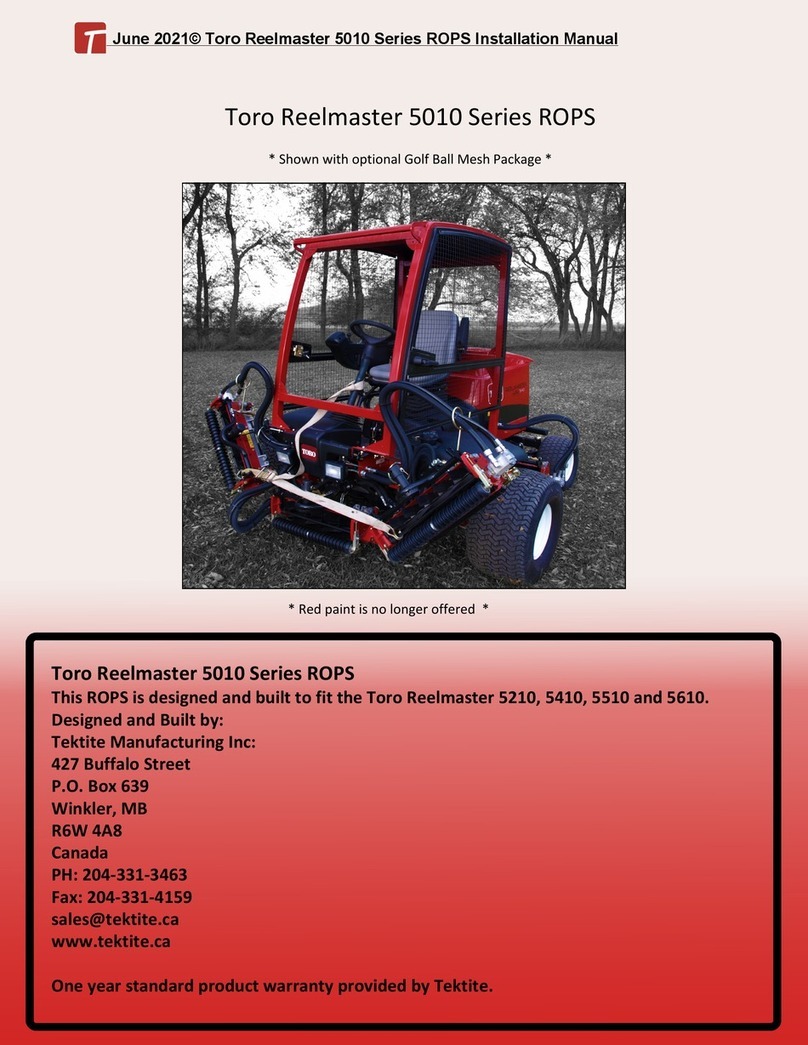
Tektite
Tektite Toro Reelmaster 5010 Series installation manual
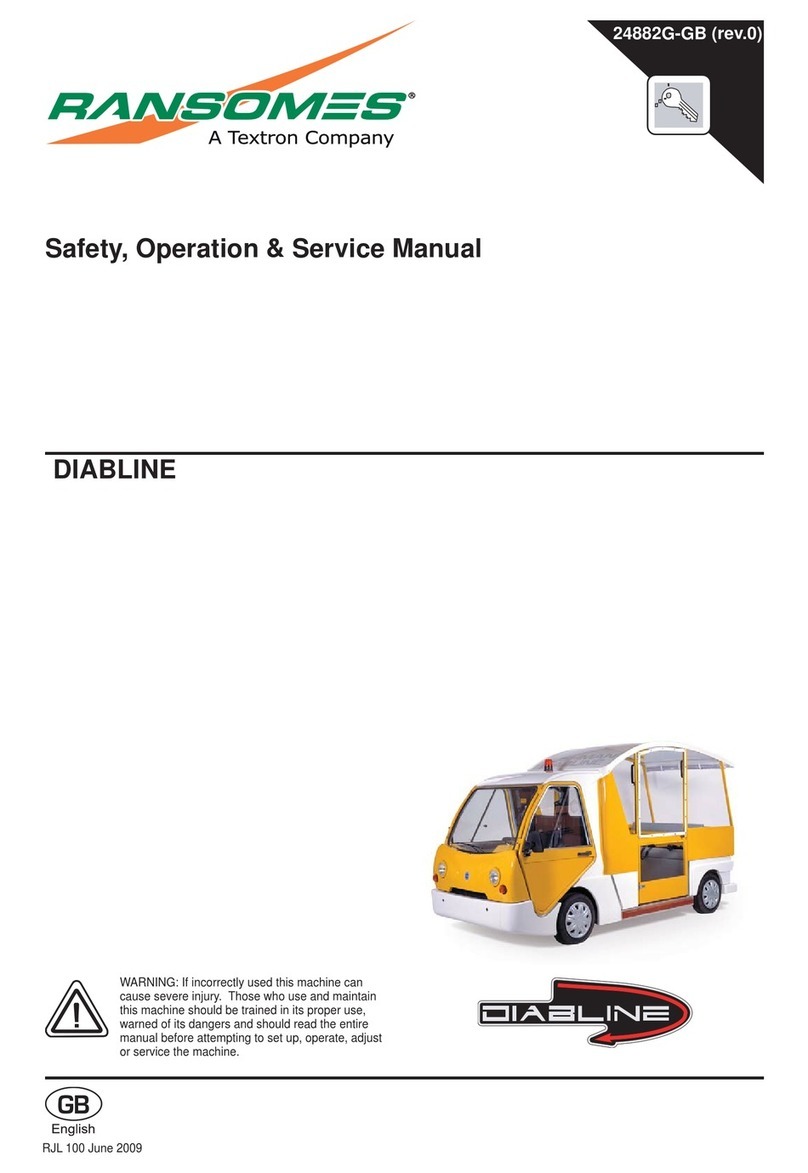
Ransomes
Ransomes diabline Operation & service manual
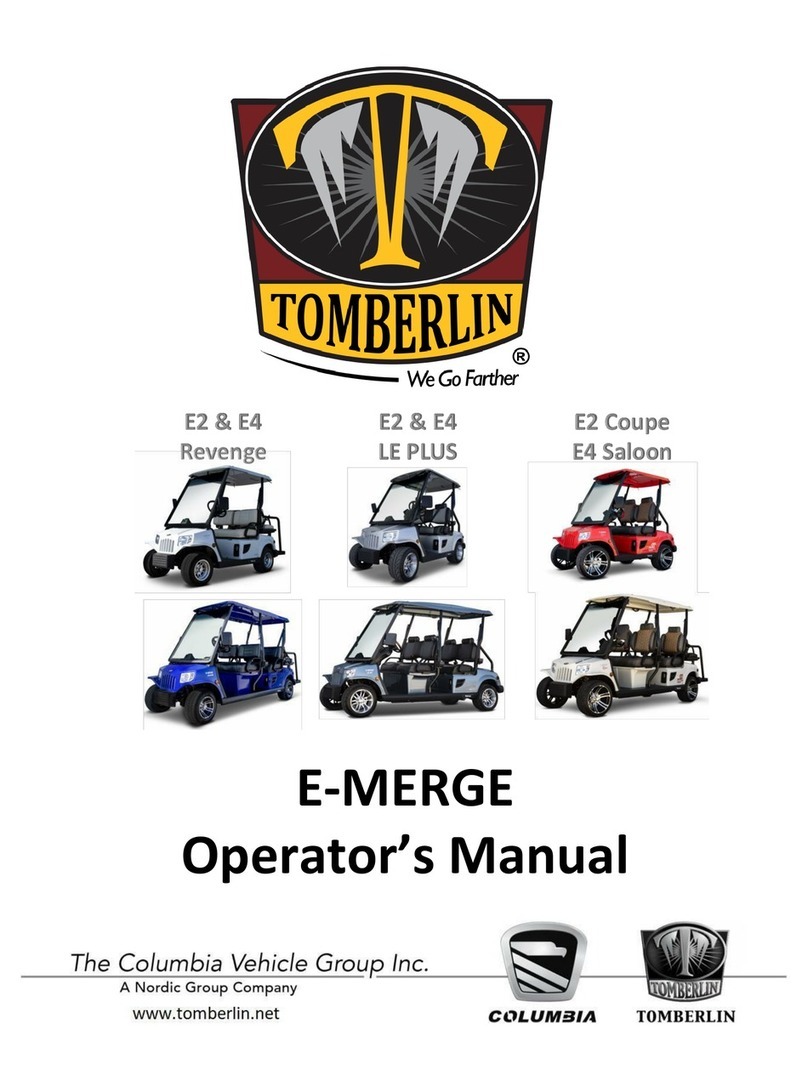
Columbia
Columbia Tomberlin E-MERGE E2 Revenge 2020 Operator's manual
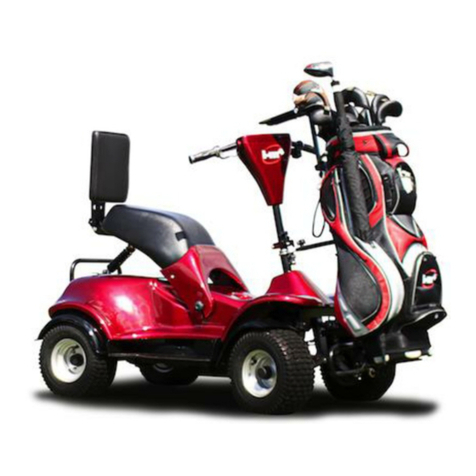
I-Motioncaddys
I-Motioncaddys im4 Range 2013 manual
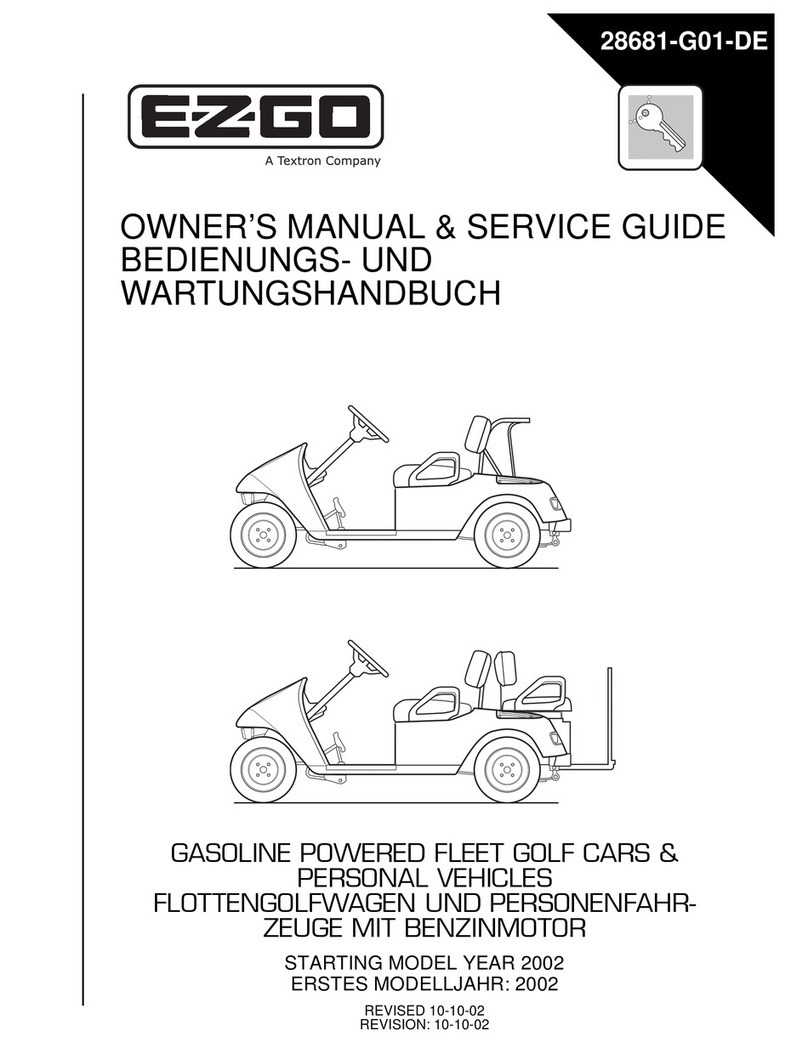
Ezgo
Ezgo TXT 2002 Owner's manual & service guide
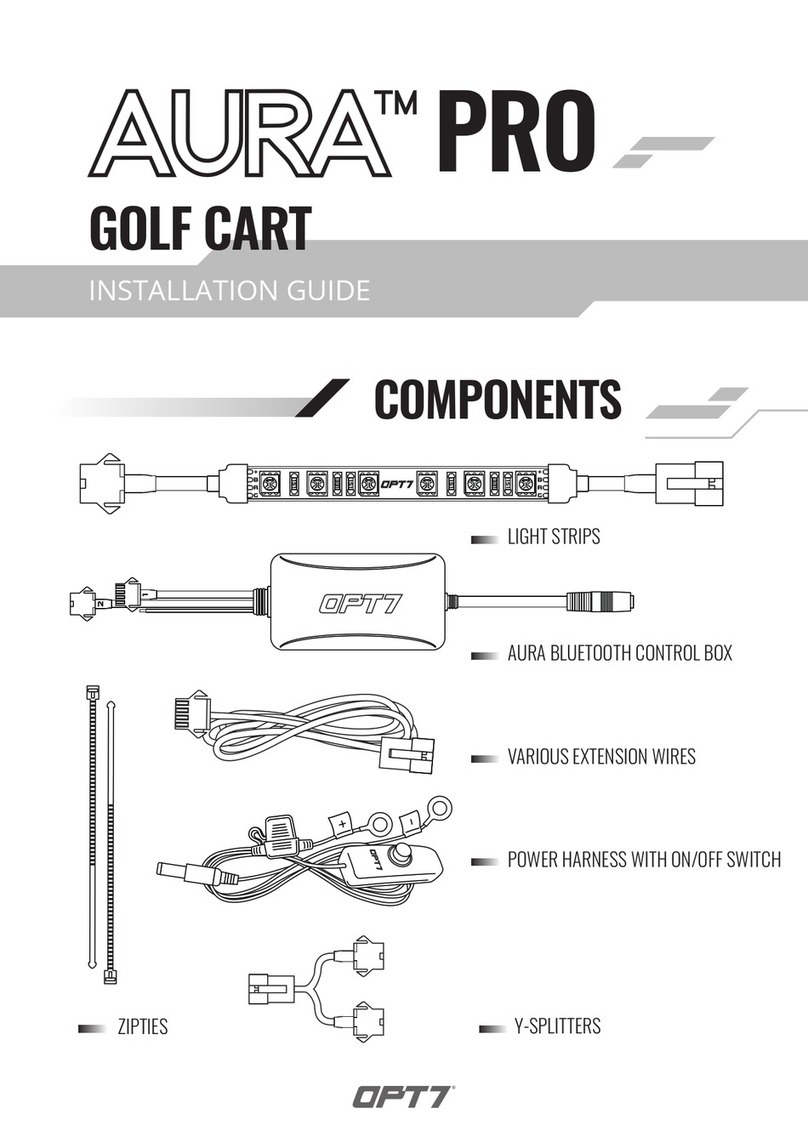
OPT7
OPT7 AURA PRO installation guide
